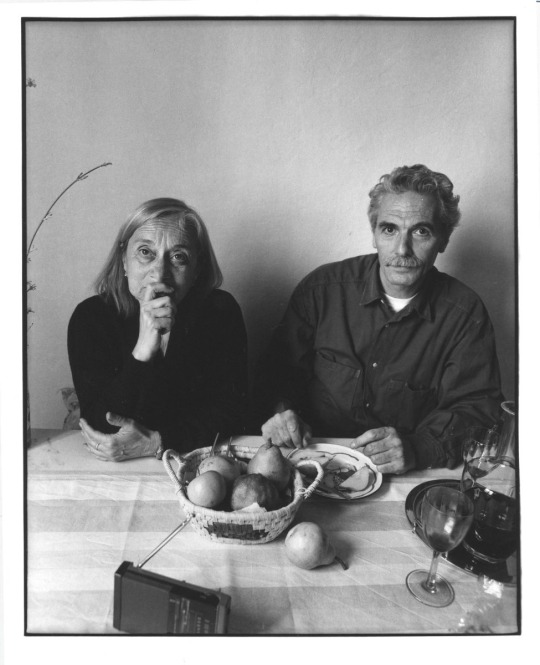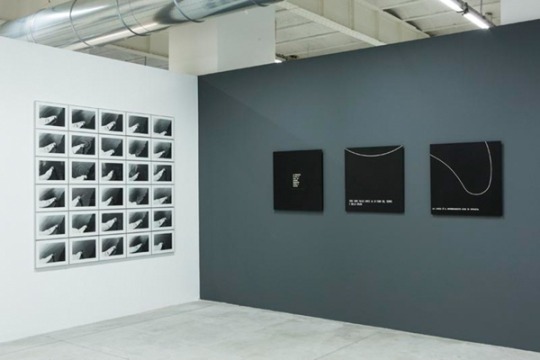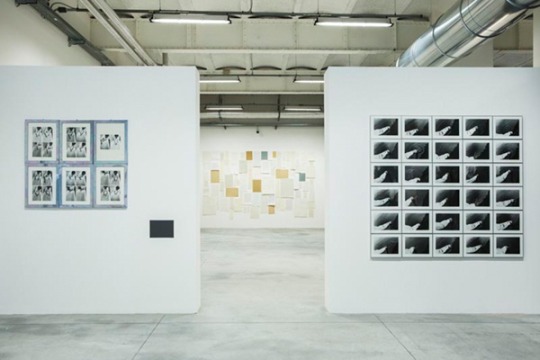#Angela Ricci Lucchi
Text
Bolzano Film Festival Bozen | Premi alla carriera per Yervant Gianikian & Angela Ricci Lucchi e Vivo film
Yervant Gianikian e Angela Ricci Lucchi – originali e straordinari protagonisti del cinema e delle arti visive
I cineasti Angela Ricci Lucchi e Yervant Gianikian sono stati compagni di lavoro e di vita fino alla morte della regista che il partner fa rivivere nei suoi ultimi film. Yervant Gianikian sarà a Bolzano per la cerimonia di premiazione.
Yervant Gianikian (1942) nasce a Merano da padre…

View On WordPress
0 notes
Text

0 notes
Text

Yervant Gianikian e Angela Ricci Lucchi, “I diari”. Mart Rovereto, agosto 2020
1 note
·
View note
Text
Morta Angela Ricci Lucchi, regista sperimentale e innovativa
Si è spenta ieri a Milano Angela Ricci Lucchi, regista sperimentale e innovativa che col compagno di origini armene Yervant Gianikian ha spinto ai limiti le forze espressive del cinema. Nata a Lugo di Romagna nel 1942, la regista si approccia all’arte in Austria grazie a Oskar Kokoschka. Negli anni ’70, col compagno Yervant Gianikian, realizza una serie di cortometraggi d’avanguardia tra cui si…
View On WordPress
0 notes
Photo

Lo specchio fluido. Il cinema d'artista, Edited by Andrea Granchi, Edizioni Galleria De Amicis, Firenze, 1978 [Exhibition: March-April, 1978] [Temporary Bookstore]. Feat. Cioni Carpi, Ugo Nespolo, Luca Patella, Gruppo 70, Lapo Binazzi (UFO), Ugo La Pietra, Superstudio, Massimo Becattini, Alberto Moretti, Plinio Martelli, Renato Ranaldi, Yervant Gianikian, Angela Ricci-Lucchi, Andrea Granchi
#graphic design#typography#art#architecture#photography#geometry#pattern#exhibition#catalogue#catalog#cover#andrea granchi#cioni carpi#ugo nespolo#luca patella#gruppo 70#lapo binazzi#ugo la pietra#superstudio#massimo becattini#alberto moretti#plinio martelli#renato ranaldi#yervant gianikian#angela ricci lucchi#edizioni galleria de amicis
24 notes
·
View notes
Photo






People, Years, Life (Uomini, anni, vita), Yervant Gianikian & Angela Ricci Lucchi, 1990
11 notes
·
View notes
Photo


Il diario di Angela – Noi due cineasti (2018) dir. Yervant Gianikian, Angela Ricci Lucchi
among my most treasured of cinematic experiences for this current decade
1 note
·
View note
Photo

MoMA Presents: Yervant Gianikian and Angela Ricci Lucchi's Angela's Diaries
1 note
·
View note
Photo

Immigration and Displacement
Monday, April 17, 7:00 pm – 9:00 pm
Hubbell Auditorium
University of Rochester
RSVP via Facebook
Free and open to the public. Refreshments provided.
On Film is excited to present the Spring 2017 program “Immigration and Displacement,�� featuring the works of Emily Hong, Miasarah Lai and Mariangela Mihai as well as Yervant Gianikian and Angela Ricci-Lucchi.
Utilizing salvaged archival footage and first-person testimony, these works reorient movement and proximity in transforming their visual and aural documents to access the living memories of historical experience. By resurrecting immigration stories from the distant and recent past of humanity and freedom of movement under threat, the urgent cinematic works in this program redefine our understandings of displacement in times of ongoing crisis. Mariangela Mihai, co-director of Nobel Nok Dah, will be in attendance for a Q&A discussion after the screening.
Program:
Nobel Nok Dah (Emily Hong, Miasarah Lai, and Mariangela Mihai, 2016, 23 min., video)
Print source: Mariangela Mihai
People, Years, Life / Uomini, anni, vita (Yervant Gianikian and Angela Ricci Lucchi, 1990, 70 min., 16mm)
Print source: MoMA Circulating Film Library
–
Sponsored by: University of Rochester Film and Media Studies Program, Graduate Program in Visual and Cultural Studies, University of Rochester Department of History, University of Rochester – AS&E Graduate Student Association, Digital Scholarship Lab, Susan B. Anthony Institute for Gender and Women’s Studies, Department of Modern Languages & Cultures, Department of Anthropology
–(Poster designed by
Adam Maida
)
0 notes
Photo

Frammenti Elettrici (1, 2, 3) - Yervant Gianikian e Angela Ricci Lucchi
https://www.youtube.com/watch?v=iRcRcFJU4X0
0 notes
Text
POPULATION
Abounaddara
Akinbode Akinbiyi
Nevin Aladağ
Danai Anesiadou
Andreas Angelidakis
Aristide Antonas
Rasheed Araeen
Ariuntugs Tserenpil
Michel Auder
Alexandra Bachzetsis
Nairy Baghramian
Sammy Baloji
Arben Basha
Rebecca Belmore
Sokol Beqiri
Roger Bernat
Bili Bidjocka
Ross Birrell
Llambi Blido
Nomin Bold
Pavel Brăila
Geta Brătescu
Miriam Cahn
María Magdalena Campos-Pons and Neil Leonard
Vija Celmins
Banu Cennetoğlu
Panos Charalambous
Nikhil Chopra
Ciudad Abierta
Marie Cool Fabio Balducci
Anna Daučíková
Moyra Davey
Yael Davids
Agnes Denes
Manthia Diawara
Beau Dick (1955–2017)
Maria Eichhorn
Hans Eijkelboom
Bonita Ely
Theo Eshetu
Aboubakar Fofana
Peter Friedl
Guillermo Galindo
Regina José Galindo
Israel Galván, Niño de Elche, and Pedro G. Romero
Daniel García Andújar
Pélagie Gbaguidi
Apostolos Georgiou
Yervant Gianikian and Angela Ricci Lucchi
Gauri Gill
Marina Gioti
Beatriz González
Douglas Gordon
Hans Haacke
Constantinos Hadzinikolaou
Irena Haiduk
Ganesh Haloi
Anna Halprin
Dale Harding
David Harding
Maria Hassabi
Edi Hila
Susan Hiller
Hiwa K
Olaf Holzapfel
Gordon Hookey
iQhiya
Sanja Iveković
Amar Kanwar
Romuald Karmakar
Andreas Ragnar Kassapis
Kettly Noël
Bouchra Khalili
Khvay Samnang
Daniel Knorr
Katalin Ladik
Lala Rukh (1948–2017)
David Lamelas
Rick Lowe
Alvin Lucier
Ibrahim Mahama
Narimane Mari
Mata Aho Collective
Mattin
Jonas Mekas
Angela Melitopoulos
Phia Ménard
Lala Meredith-Vula
Gernot Minke
Marta Minujín
Naeem Mohaiemen
Hasan Nallbani
Joar Nango
Rosalind Nashashibi and Nashashibi/Skaer
Negros Tou Moria
Otobong Nkanga
Emeka Ogboh
Olu Oguibe
Rainer Oldendorf
Pauline Oliveros (1932–2016)
Joaquín Orellana Mejía
Christos Papoulias
Véréna Paravel and Lucien Castaing-Taylor
Benjamin Patterson (1934–2016)
Dan Peterman
Angelo Plessas
Nathan Pohio
Pope.L
Postcommodity
Prinz Gholam
R. H. Quaytman
Gerhard Richter
Abel Rodríguez
Tracey Rose
Roee Rosen
Arin Rungjang
Ben Russell
Georgia Sagri
Máret Ánne Sara
Ashley Hans Scheirl
Marilou Schultz
David Schutter
Algirdas Šeškus
Nilima Sheikh
Ahlam Shibli
Zef Shoshi
Mounira Al Solh
Annie Sprinkle and Beth Stephens
Eva Stefani
K. G. Subramanyan (1924–2016)
Vivian Suter
El Hadji Sy
Sámi Artist Group (Keviselie/Hans Ragnar Mathisen, Britta Marakatt-Labba, Synnøve Persen)
Terre Thaemlitz
Piotr Uklański
Jakob Ullmann
Antonio Vega Macotela
Cecilia Vicuña
Annie Vigier & Franck Apertet (les gens d’Uterpan)
Wang Bing
Lois Weinberger
Stanley Whitney
Elisabeth Wild
Ruth Wolf-Rehfeldt
Ulrich Wüst
Zafos Xagoraris
Sergio Zevallos
Mary Zygouri
Artur Żmijewski
Zainul Abedin (1914–1976)
Stephen Antonakos (1926–2013)
Arseny Avraamov (1886–1944)
Ernst Barlach (1870–1938)
Étienne Baudet (ca. 1638–1711)
Samuel Beckett (1906–1989)
Franz Boas (1858–1942)
Arnold Bode (1900–1977)
Lorenza Böttner (1959–1994)
Marcel Broodthaers (1924–1976)
Lucius Burckhardt (1925–2003)
Abdurrahim Buza (1905–1986)
Vlassis Caniaris (1928–2011)
Sotir Capo (1934–2012)
Cornelius Cardew (1936–1981)
Ulises Carrión (1941–1989)
Agim Çavdarbasha (1944–1999)
Chittaprosad (1915–1978)
Jani Christou (1926–1970)
Chryssa (1933–2013)
André du Colombier (1952–2003)
Gustave Courbet (1819–1877)
Christopher D’Arcangelo (1955–1979)
Bia Davou (1932–1996)
Maya Deren (1917–1961)
Ioannis Despotopoulos (1903–1992)
Thomas Dick (1877–1927)
Carl Friedrich Echtermeier (1845–1910)
Maria Ender (1897–1942)
Forough Farrokhzad (1935–1967)
Conrad Felixmüller (1897–1977)
Pavel Filonov (1883–1941)
Niccolò di Pietro Gerini (1340–1414)
Tomislav Gotovac (1937–2010)
Jacob and Wilhelm Grimm (1785–1863, 1786–1859)
Ludwig Emil Grimm (1790–1863)
Giovanni di ser Giovanni Guidi (1406–1486)
Cornelia Gurlitt (1890–1919)
Louis Gurlitt (1812–1897)
Nikos Hadjikyriakos-Ghika (1906–1994)
Oskar Hansen (1922–2005)
Sedje Hémon (1923–2011)
Theodor Heuss (1884–1963)
Karl Hofer (1878–1955)
Ralph Hotere (1931–2013)
Albert Jaern (1893–1949)
Iver Jåks (1932–2007)
Sunil Janah (1918–2012)
Alexander Kalderach (1880–1965)
Tshibumba Kanda Matulu (1947–1981 disappeared)
Leo von Klenze (1784–1864)
Kel Kodheli (1918–2006)
Louis Kolitz (1845–1914)
Spiro Kristo (1936–2011)
KSYME-CMRC (founded 1979)
Anna “Asja” Lācis (1891–1979)
Maria Lai (1919–2013)
Yves Laloy (1920–1999)
Valery Pavlovich Lamakh (1925–1978)
George Lappas (1950–2016)
Karl Leyhausen (1899–1931)
Max Liebermann (1847–1935)
George Maciunas (1931–1978)
Ernest Mancoba (1904–2002)
Oscar Masotta (1930–1979)
Mikhail Matyushin (1861–1934)
Pandi Mele (1939–2015)
Tina Modotti (1896–1942)
Benode Behari Mukherjee (1904–1980)
Krzysztof Niemczyk (1938–1994)
Ivan Peries (1921–1988)
David Perlov (1930–2003)
André Pierre (1915–2005)
Dimitris Pikionis (1887–1968)
Dmitri Prigov (1940–2007)
Hasan Reçi (1914–1980)
W. Richter
Anne Charlotte Robertson (1949–2012)
Erna Rosenstein (1913–2004)
August Wilhelm and Friedrich Schlegel (1767–1845, 1772–1829)
Bruno Schulz (1892–1942)
Scratch Orchestra (1969–1974)
Tom Seidmann-Freud (1892–1930)
Allan Sekula (1951–2013)
Baldugiin Sharav (1869–1939)
Amrita Sher-Gil (1913–1941)
Vadim Sidur (1924–1986)
August Spies (1855–1887)
Foto Stamo (1916–1989)
Gani Strazimiri (1915–1993)
Władysław Strzemiński (1893–1952)
Alina Szapocznikow (1926–1973)
Yannis Tsarouchis (1910–1989)
Antonio Vidal (1928–2013)
Albert Weisgerber (1878–1915)
Lionel Wendt (1900–1944)
Johann Joachim Winckelmann (1717–1768)
Fritz Winter (1905–1976)
Basil Wright (1907–1987)
Andrzej Wróblewski (1927–1957)
Ivan Wyschnegradsky (1893–1979)
Iannis Xenakis (1922–2001)
Androniqi Zengo Antoniu (1913–2000)
Pierre Zucca (1943–1995)
Documenta14, 2017
11 notes
·
View notes
Photo







Catalogo karagoez 9.5, Yervant Gianikian & Angela Ricci Lucchi, 1981
23 notes
·
View notes
Photo


“L’Inarchiviabile/The Unarchivable. Italia anni 70” at FM Centro per l’Arte Contemporanea, Milan
FM Centre for Contemporary Art, a new artistic and cultural center unique within Italy, opens with the great exhibition “L’Inarchiviabile/The Unarchivable. Italia anni 70” curated by Marco Scotini in collaboration with Lorenzo Paini, with the presence of almost sixty artists and more than two hundred works from the most prestigious private Italian art collections.
The exhibition presents both a critical review and, at the same time, a widespread survey of the Italian artistic scene in the 1970s with works and historic documents aiming to investigate a great heterogeneity of artistic and editorial formats and which reveal, amongst this vast multitude of forms of collective statements, new linguistic devices and a plurality of subjectivities. This was a decade of great productivity in which culture ‘went beyond’ the field of aesthetics, overflowing into languages that resist cataloguing and into ephemeral practices and actions linked to social performability and based on temporality.
“These were the years in which part of the Venice Biennale (1972 edition) – Scotini states – was dedicated to ‘The book as a place of research’ and in which the expression ‘Off media’ proposed by Germano Celant took hold. This is why we have wanted to include, as well as works of art in the classic sense, also photographic reporting, musical scores, radical architectural projects, forms of film, etc. However, the ‘going beyond’ referred to is that of the emergence of social creativity, of general intellect, substantially. This was an aspiration to go beyond the norm and typologies in relation to an (arguably so) unarchivable desire which can be summarized as the space standing between Nanni Balestrini’s subversive ‘We Want it All’ and Anselmo’s metaphysical ‘Everything’”.
The “unarchivable” refers to the surfacing of various, plural social forces opposing the organization and control of labor, affirmative practices of the multi-disciplinary approach that characterized the 1970s in Italy, as also did the new examples of liberation linked to feminist experiences, the questions around gender and the relationship with the political.
If that which becomes history is always determined by that which has been archived, at the same time, the archive reactivates narratives that have never been told once and for all. Thus memory also becomes continuously revocable in an era in which time is the subject of expropriation. In a continuous dialogue between the artistic paradigm and editorial productions, the works and documents on display find their own conditions of appear- ance and existence in this impossibility of – or reluctance to– being archived.
So, “L’Inarchiviabile/The Unarchivable” puts on display the topicality and rediscovery of a decade of great intensity and of linguistic and political experimentation for the Italian and international scene, but also a reflection on the contemporary nature of the archive as a format. All the works from the decade of the 1970s on exhibition are already in the form of an atlas, a catalogue, an inventory and represent in themselves collections, taxonomies, attempts at catalogization on the part of the artists.
From Alighiero Boetti’s classifications to Mario Merz’s sequences of Fibonacci numbers to Paolini’s La Doublure, a collection of white canvases that represent themselves in perspective and are differentiated only by their titles on the back. Or Ghirri’s 1973 Atlante, Nannucci’s Zona archive or Baruchello’s Leftover, through to Mauri’s archive of Linguaggio è Guerra, to Franco Vaccari’s collection of passport photos, Gianikian and Ricci Lucchi’s filmic, perfumed catalogues and Nanni Balestrini’s textual assemblages. If in the same period, the radical nature of Italian feminism led Carla Lonzi to abandon art criticism because it is “through her absence that a woman makes a gesture of awareness, liberating and, therefore, creative”, there is a considerable female presence in the exhibition: from Carla Accardi to Dadamaino, from Marisa Merz to Maria Lai, from the photographs of Marcella Campagnano and Lisetta Carmi, through to Ketty La Rocca’s pre-verbal inventory.
“L’Inarchiviabile/The Unarchivable” is a concentrate of these experiences that go through to the Parco Lambro in 1977 as an affirmation of the multitude and of a plurality of molecular insurgencies, constitutionally unarchivable. Alberto Grifi was unable to encapsulate in a finished film the shooting of the events of the Festival del Proletariato Giovanile [Festival of the Young Proletariats] at the Lambro, producing a work that was not a single film but many films at one and the same time, a multiplicity of filming that permits endless new social re-combinations.
It is precisely in the name of this plurality that is no longer able to summarize itself that FM Center for Contemporary Art had decided to open its activities with the figure of the archive, the collection, the catalogue as the interpretative keys of our present day.
“L’Inarchiviabile/The Unarchivable” includes 200 works by 60 artists from the main private Italian collections.
Artists: Carla Accardi, Vincenzo Agnetti, Giovanni Anselmo, Nanni Balestrini, Gianfranco Baruchello, Irma Blank, Alighiero Boetti, Sylvano Bussotti, Marcella Campagnano, Lisetta Carmi, Giuseppe Chiari, Gianni Colombo, Dadamaino, Gino De Dominicis, Mario Diacono, Luciano Fabro, Yervant Gianikian & Angela Ricci Lucchi, Luigi Ghirri, Piero Gilardi, Paolo Gioli, Global Tools, Alberto Grifi, Paolo Icaro, Emilio Isgrò, Jannis Kounellis, Ugo La Pietra, Ketty La Rocca, “La Traviata Norma”, Laboratorio di Comunicazione Militante, Maria Lai, Uliano Lucas, Walter Marchetti, Fabio Mauri, Mario Merz, Marisa Merz, Ugo Mulas, Maurizio Nannucci, Giulio Paolini, Claudio Parmiggiani, Luca Maria Patella, Giuseppe Penone, Gianni Pettena, Vettor Pisani, Michelangelo Pistoletto, Emilio Prini, Salvo, Aldo Tagliaferro, Franco Vaccari, Franco Vimercati, Michele Zaza, Gilberto Zorio.
.
at FM Centro per l’Arte Contemporanea, Milan
until 15 June 2016
3 notes
·
View notes
Photo

Manos en ‘Vues d’Espagne en cartes postales’ (Anónimo, 1907) y en ‘À propos de nos voyages en Russie’ (Yervant Gianikian y Angela Ricci Lucchi, 2016).
0 notes
